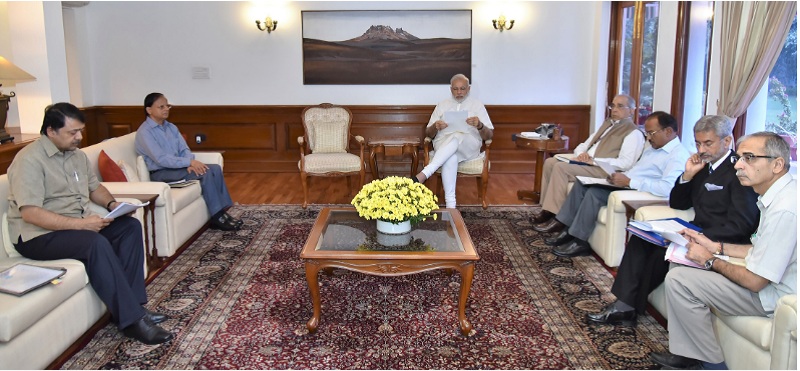By Prabhakar Singh
On May 7, India conducted “precision strikes” under Operation Sindoor, destroying “terrorist infrastructure” at nine sites in Pakistan and Pakistan Occupied Kashmir.
These steps were taken in the wake of a terrorist attack in Pahalgam, where 25 Indians and one Nepalese tourist were killed.
A week before the precision strikes, as part of a slew of diplomatic responses to the attack, India announced that it was holding the Indus Water Treaty (IWT), 1960, in “abeyance”.
This is, according to India, neither an attack nor an act of war on Pakistan. Pakistan, though, thinks otherwise.
River treaties
Since its independence in 1947, India has signed bilateral river treaties with Pakistan, Nepal, and Bangladesh.
Take the IWT, signed between India and Pakistan, for instance. The treaty on sharing of waters of the rivers under the Indus system was signed after mediation by the World Bank in 1960. It allows India an “unrestricted use” of waters of the eastern rivers, namely Sutlej, Beas, and Ravi. Pakistan has similarly unrestricted use of waters of the western rivers in the Indus Basin — the Jhelum, Chenab, and Indus itself, with certain dam-building rights to India.
Subsequent river treaties signed between India and Nepal, and India and Bangladesh in 1996, were also of historic importance in the context of “hydro-diplomacy” in South Asia.
The success of these treaties can be seen as a significant diplomatic milestone — India and China, for instance, have not succeeded in signing a treaty for the use of the waters of the Brahmaputra river.
In recent times, however, hydro-diplomacy seems to have run its course in South Asia.
Holding in abeyance
This is the first time that IWT has been held “in abeyance” since it was signed, making the step extraordinary.
All international treaties are governed by the Vienna Convention on the Law of Treaties (VCLT), 1969. India is not a party to the Convention. However, the Indian Supreme Court has accepted VCLT as customary international law.
The VCLT does not mention the phrase “holding in abeyance”; Article 62 of the VCLT on “fundamental change in circumstances” only talks about termination, withdrawal, and suspension. This means that the treaty can only be withdrawn under certain circumstances.
A previous IWT dispute between India and Pakistan at the Permanent Court of Arbitration (PCA) lends clues to conditions, if any, under which the sharing of waters can be disrupted.
In 2010, Pakistan approached the PCA to settle a dispute with India over the permissibility of the construction of a hydro-electric project (the Kishenganga Hydro-Electric Project) by India on the Kishenganga/Neelum River, a tributary of the Jhelum River, a western river.
Pakistan had also asked the PCA to determine whether India could deplete, or bring the reservoir level of “run-of the river” hydro-electric plants below a level identified as “dead storage level” in the IWT.
The treaty defines “dead storage” as “that portion of storage which is not used for operational purposes.”
The contention was that such reservoir depletion would give India “impermissibly broad control” over the flow of the river waters allocated to it.
In December 2013, in the Indus Waters Kishanganga Arbitration, the PCA ruled that only during an “unforeseen emergency” could India consider depleting, or bringing the reservoir level of a run-of-river plant below dead storage level.
In its ruling, the PCA ended up hinting at rethinking the Award for “circumstances in which its reasoning no longer accords with reality along the Kishenganga/Neelum” project.
Thus, the court kept open to international judicial reconsideration the idea of “unforeseen emergency” under IWT.
“Unable or unwilling”
In August 2024, India had sent a formal notice to Pakistan as specified under Article 12, IWT, to modify the treaty. The annual meetings of the Permanent Indus Commission too were put on hold until Pakistan came to the table to “renegotiate” the IWT.
In the formal notice, besides expressing concerns on altered population demographics, India had noted that “persistent cross-border terrorism” in Jammu and Kashmir was “impeding smooth operations” of the treaty, and “undermining the full utilisation of its rights in the Indus”.
India thus hinted at Pakistan’s lack of cooperation — citing terrorism as one of the issues — in helping it utilize its treaty rights on a western river along the Line of Control.
The Line of Control in Kashmir is the result of the Simla Agreement that ended the 1971 War between India and Pakistan.
The 2024 notice had, therefore, explicitly linked India’s ability to honour IWT with Pakistan’s responsibility to end terrorism directed against India.
Is then India’s step to hold the treaty in abeyance a legal countermeasure or reprisal — like the American action in the Persian Gulf — against terrorism by Pakistan?
Perhaps not.
First, because IWT was honoured even during the Indo-Pakistan wars of 1965, 1971, and 1999. Second, India’s notice in 2024 to Pakistan on IWT had mentioned terrorism as only one of the impediments, alongside demographic change and a few other issues, as hurdles in honouring the IWT.
What then might be India’s justification for such a move?
India’s international legal arguments on terrorism emerging from Pakistan, as described by noted jurist PS Rao, India’s chief legal advisor (1985-2002) and judge ad hoc at the International Court of Justice, The Hague, are based on the doctrine of “unable or unwilling”.
This doctrine expands the idea of self-defence in Article 51, UN Charter, 1945, on “non-state actors”. Terrorists are notable non-state actors in the war on terror. Pakistan’s defence minister Khawaja Asif’s recent confession about doing the “West’s dirty work for decades” only proves that non-state actors have been used as mercenaries against India.
In a first application of the doctrine, the Indian government under PM Narendra Modi had conducted a “surgical strike” in wake of a terrorist attack in 2016.
As such, India’s “precision” strikes — originally an Israeli doctrine applied in the Entebbe raid in Uganda — in 2016 and 2025, are not an attack on Pakistani territory but only on terrorists and non-state actors lodged in Pakistan’s territory that Islamabad was either “unable or unwilling” to act upon.
On May 7, Foreign Secretary Vikram Misri’s statement on “Operation Sindoor” hinted at India’s lawfare in saying “there has been no demonstrable step from Pakistan to take action against the terrorist infrastructure on its territory, or on territory under its control.”
Thus, as far as India is concerned, Pakistan is unwilling to end terrorism against India.
Misri’s statement notes that the strikes were “measured, non-escalatory, proportionate, and responsible.” In his statement, he also quoted the United Nations Security Council’s Press Statement on the Pahalgam terror attack to argue that India’s actions were aligned with it.
Likewise, India’s Press Information Bureau’s statement that “no Pakistani military have been targeted” sought to underline the legality within international law of India’s actions.
These justifications will help India prove the illegality of Pakistan’s actions in targeting civilians on the Indian side of the Line of Control in Kashmir, and consequently justify India’s moves, including on the IWT.
Choppy waters
India is not sacrificing lawfare in the heat of the moment.
Its two pronged response — the decision to hold the IWT in abeyance, followed by precision strikes — can be seen as lawfare against Pakistan.
Nonetheless, South Asia has seen the value of treaties — river treaties in particular — in keeping peace in the region.
In 2026, the Ganga Water Treaty between India-Bangladesh would be up for renewal, and given recent developments, would test the relationship between the two countries.
When it comes to peace in South Asia, it seems that the lines will be drawn on water first.
Prabhakar Singh is Professor at School of Law BML Munjal University, Haryana and International Advisor to Restatement of the Law Fourth, the Foreign Relations Law of the United States, The American Law Institute, Pennsylvania. On X, he posts from the handle @OolongTeaCher.
Originally published under Creative Commons by 360info™.














